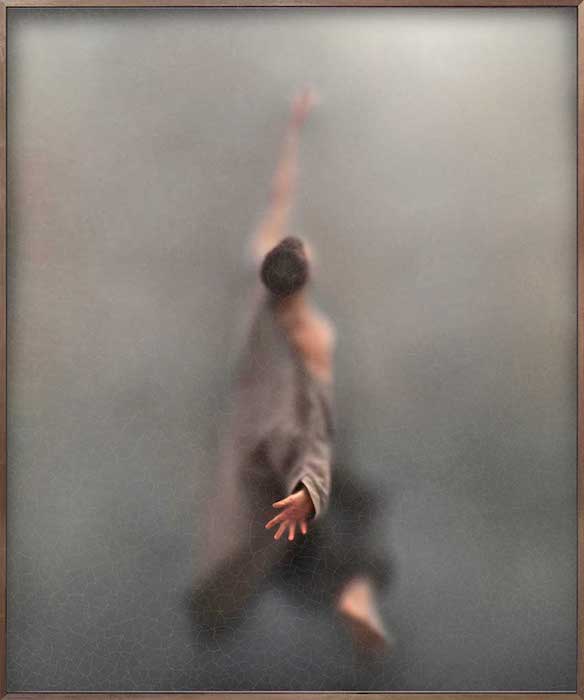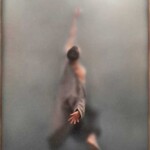Exhibition
in Zürich / Switzerland
- Casper Faassen: Levitate II, 2019, Ölfarbe, farbiger und weisser Druck auf Setasand-Acrylglas, 180 x 150 cm
- Casper Faassen: Levitate I, 2019, Ölfarbe, farbiger und weisser Druck auf Setasand-Acrylglas, 180 x 150 cm
- Casper Faassen: Mono No Aware II, 2020, Ölfarbe, farbiger und weisser Druck auf Setasand-Acrylglas, 120 x 180 cm
- Casper Faassen: Recollection IX, 2020, Ölfarbe, farbiger und weisser Druck auf Setasand-Acrylglas, 35 x 25 cm
Bildhalle is proud to announce a new addition to the gallery, the renowned Dutch artist Casper Faassen.
Viewing Faassen’s work is akin to peering through the mists of time. With a studio in Leiden, the birthplace of Rembrandt, the artist takes inspiration from the classical paintings to which he was introduced as a young boy in The Netherlands. Specifically, he approaches the vanitas genre of still-life painting from a new perspective, developing a unique visual language through the combination of photography, paint, and the application of craquelure.
In his own words: “The juxtaposition between the eternal and the temporal, beauty and decay, appearing and disappearing is my main theme. All painters and photographers have the ability to freeze time and capture a single moment. I emphasize that moment by adding an element of time – not necessarily by using literal vanitas references but through the handling of materials. The use of craquelure is my symbol for time and introduces a visual element since it is oil paint and thus sharp, contrasting with the rest of the blurry image. Most of the distance is created by the way the picture is taken, through a matte medium. I print the image on to that same matte medium giving a further sense of distance. What I also like about the craquelure is the texture it gives to the surface or skin. The work becomes more material, more substantial, pointing toward painting instead of photography and thus encouraging a different way of perceiving the work. Within this visual language I`ve grown so comfortable with, I love to explore different themes.”
“Here we are, caught in the middle. Falling, soaring or floating. I see now that most of my recent works depict that moment where gravity seems lost and we don’t clearly see where we are or where we are going. We levitate. The juxtaposition between the eternal and the temporal, beauty and decay, appearing and disappearing is my main theme. All painters and photographers have the ability to freeze time and capture a single moment. I emphasize that moment by adding an element of time – not necessarily by using literal vanitas references but through the handling of materials. I do that through the use of an oil paint craquelure layer, contrasting the blurry image. Most of the distance is created by the way the picture is taken, through a matte medium. I print the image on to that same matte medium giving a further sense of distance. The layered image refers more to painting than photography and gives the viewer a sense of ease looking at it. We are not in the same place, the subject is unaware of our presence.” (Casper Faassen)
Casper Faassen (*1975, NL) grew up in Leiden. It was there that he developed his passion for drawing, painting and art. Famous Leiden masters – Gerrit Dou (1613-1675), Jan Steen (1625-1679) and Rembrandt van Rijn (1606-1669) – were his inspiration. After leaving high school Faassen studied at the University of Amsterdam. He continued to pursue his artistic ambitions, painting daily and thus compiling an impressive oeuvre. The influence of Amedeo Modigliani (1884-1920) in his work – in particular his (female) nudes – can clearly be seen in both subject matter and strong line definition.
Characteristic of Faassen’s works is his ongoing innovative approach to material, techniques and disciplines. In addition to painting and graphic art, Faassen devotes much of his time to the medium of photography. It is in his photographic work that we recognize the Leiden painters who inspired him. His distinctive works depict their classic 17th-century themes such as cityscapes, vanitas paintings and flower arrangements.
A look at Faassen’s œuvre as a whole reveals that such themes as transience, beauty and female splendour form the basis of his work.
Gallery hours Wed-Fri 12 – 6:30 pm, Sat 11 am – 4 pm
Die Bildhalle Zürich & Amsterdam freut sich, neu den renommierten niederländischen Künstler Casper Faassen zu repräsentieren.
Die Arbeit Casper Faassens zu betrachten ist wie ein Blick durch den Nebel der Zeit. Aufgewachsen in Leiden, dem Geburtsort von Rembrandt, wo er heute noch in seinem Atelier tätig ist, lässt sich Faassen von jenen klassischen Gemälden inspirieren, denen er in seiner Jugend begegnete. Insbesondere nähert er sich dem Genre der Vanitas-Stillleben aus einer neuen Perspektive und entwickelt durch die Kombination von Fotografie, Ölfarbe und “Craquelé” (Oberflächenrisse) eine unverwechselbare visuelle Sprache.
Casper Faassen mit seinen eigenen Worten: “Die Gegenüberstellung von Schönheit und Zerfall ist das Hauptthema meiner künstlerischen Arbeit. Alle Maler und Fotografen haben die Fähigkeit, die Zeit einzufrieren und einen Moment festzuhalten. Ich unterstreiche diese Fähigkeit, indem ich Elemente der Zeit hinzufüge. Nicht unbedingt durch die Verwendung von Symbolen der Vergänglichkeit, sondern durch den Umgang mit Materialien. Die rissige Oberfläche ist meine Art, Zeit hinzuzufügen. Indem ich durch ein mattes Medium hindurch fotografiere, stelle ich eine Distanz zwischen dem Betrachter und dem fotografierten Objekt her. Durch das Craquelé entsteht eine Textur, die das Werk materieller und malerischer macht. Die Oberfläche lädt dazu ein, das Werk als Gemälde, nicht als Fotografie zu betrachten.”
Casper Faassen (*1975, NL) wuchs in Leiden auf, einer Stadt in der Provinz Südholland. Hier entwickelte sich seine Liebe zur Malerei und zum Zeichnen, ist Leiden doch bekannt als Geburtsort der berühmten Altmeister Rembrandt van Rijn, Gerrit Dou und Jan Steen.
Nach dem Abitur studierte Casper Faassen an der Universität Amsterdam. Er verfolgte weiterhin seine künstlerischen Ambitionen, malte täglich und stellte so ein beeindruckendes Oeuvre zusammen. Charakteristisch für Faassens Werk ist der innovative Einsatz von verschiedenen Materialien und Techniken. Neben der Malerei widmet Casper Faassen einen Grossteil seiner Zeit dem Medium der Fotografie. In seinem fotografischen Werk erkennen wir die Leidener Maler des 17. Jahrhunderts, die ihn inspiriert haben. Die Portraits, Landschaften, Akte, Stadtansichten und Stillleben – alles traditionelle Motive der niederländischen Kunst des 17. Jahrhunderts – werden in eine einzigartige, figurative Bildsprache übersetzt, in der Schönheit und Vergänglichkeit die zentralen Themen sind.
Seine Arbeiten befinden sich sowohl in privaten als auch in öffentlichen Sammlungen wie dem Frans Hals Museum (Haarlem), Museum de Lakenhal (Leiden) und dem Haagsch Historisch Museum. Ausstellungen fanden unter anderem im Fotografiska Museum in Stockholm und im Japanmuseum Sieboldhuis in Leiden statt. Er gewann den ALPA Award an der Photo Basel 2019 und während der AIPAD in New York kürte ArtNet seine Arbeit zu einem der sieben überzeugendsten Werke.
Öffnungszeiten Mi-Fr 12 – 18.30 Uhr, Sa 11 – 16 Uhr
Location:
Bildhalle
Stauffacherquai 56
8004 Zürich
Switzerland





